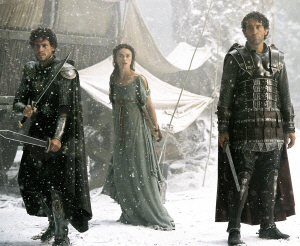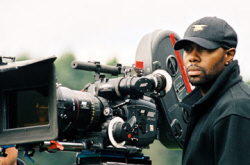Making movies. Enjoying movies. Remembering movies.
|
By
William Kallay

Sometimes a film comes out in theatres, and no matter how good its intentions are, it doesn’t perform well at the box office. Take the case of Jerry Bruckheimer’s valiant production of “King Arthur,” an epic that was released in the summer of 2004. Directed by Antoine Fuqua (“Training Day,” 2001), the uncut version of the film was recently unveiled on the big screen at the ArcLight Cinemas in Hollywood, CA to a sold-out crowd. This one-showing-only event was done in anticipation of the film’s release on DVD. Producer Bruckheimer and writer David Franzoni (“Gladiator,” 2000) were guest speakers that evening. Fuqua was also scheduled to appear, but had to cancel due to the flu.
So why is Disney pushing “King Arthur” into the public spotlight now? There’s a DVD now in release of the film’s “uncut and extended” version. But, also, here’s a case of a film that deserves an audience.
The film came out during the summer and promptly disappeared from theatres. It had Jerry Bruckheimer’s name on the marquee, an Oscar-winning screenwriter who penned the script, and a hot director helming the production. What it didn’t have was a marquee star or effective marketing in the United States. Bruckheimer, during the Q & A after the film, emphasized that he was trying to find an actor to play the role of Arthur, rather than trying to cast the film based on star power. Clive Owen (“Closer,” 2004), was cast in the lead as Arthur. He’s a respected actor, but most American audiences are unfamiliar with him. Keira Knightley plays Guinevere, but audiences might only be familiar with her in “Pirates Of The Caribbean” (2003).
 |
|
David Franzoni and Jerry Bruckheimer |
The marketing of the film portrayed it as a gritty action film, as it is in the uncut version, but perhaps that also led to its undoing. It’s “Braveheart” meets “Gladiator.” A great combo, but it’s possible that audiences felt like they had been there and done that already. Plus, the Arthurian legends have usually been told through rose-tinted glasses and soft-focus from “Camelot” (1967) to John Boorman’s “Excalibur” (1981). And why is Guinevere killing all of those Saxons and not belting out Lerner & Loewe show tunes instead? This wasn’t the customary King Arthur people were used to, and it’s a shame that many didn’t give this film a chance.
“King Arthur” is reminiscent of some of the epics of the 1960s, like “Spartacus” and “El Cid,” in which a heroic leader takes his loyal troops into battle. Slawomir Idziak’s excellent widescreen cinematography takes us into the world of Romans, Saxons and Sarmatians. Unlike numerous versions of the Arthurian myths so prominent in culture, this new re-imagining of Arthur takes place in the grit and grime of early Britain. Owen plays a sympathetic warrior named Artorious Castus who takes his knights on one last mission before they can have their freedom from Rome. There are the traditional characters of the Arthurian tales, like Lancelot (Ioan Gruffudd) and Guinevere, but they’re portrayed in a much different and more effective way than in past attempts, like in “Camelot.” This version of the tale is far more realistic and graphic. The audience doesn’t see a bunch of knights running around the English countryside singing love ballads. This film, rather, is feisty, fun, and violent.
Within Franzoni’s screenplay is a detailed history of the warring factions in Britain at the time his story takes place. Rome is waning in power. Arthur, the reluctant hero and a man devoted to his knights, doesn’t want any more bloodshed and sees all men (and women) as free. Lancelot is still his loyal friend, but Guinevere isn’t the lady lying in wait. She’s a fierce and opinionated person who shoots with a real bow and arrow. You don’t want to mess around with this Guinevere! And there isn’t the usual love triangle happening between Arthur, Guinevere and Lancelot, though there are traces of impending romance between her ladyship and Lancelot.
I did not see, like many people, the original PG-13 theatrical release version of “King Arthur,” so I can’t judge the two versions and what cuts were made. The uncut version is violent, but it seems tame compared to “Braveheart” or “Gladiator.” Bruckheimer remarked that Fuqua saw the Saxons as “Hell’s Angels of the 5th Century,” and while they’re certainly merciless in this film, they seem like a mixture of mosh pit regulars rather than Hell’s Angels.
The action scenes are well-staged and much more realistic than some of the ones done in recent epics like “Troy.” I didn’t get a sense of CGI soldier overkill. Most of the action on the screen was realistic, as were the sets, which included a mile-long version of the Hadrian Wall.
 |
|
Director Antoine Fuqua |
One of the standout scenes in the film takes place on an icy lake, in which King Arthur and his knights (outnumbered), battle the Saxons. Snow is falling, ice is cracking and soldiers are fighting. Combine these elements with crisp editing, and you’ve got yourself a rousing battle sequence. Mr. Bruckheimer said, in essence, that this one will go down as one of the great action scenes in cinema history. Time will tell, as they say. But it is very well-done and entertaining to watch.
For as much effort that went into the making of this film, it must be gratifying to those who made it to be able to see this longer and uncut version. Though the film isn’t perfect, it’s good escapist entertainment. The final battle is a little overdrawn. And unlike other “dude” movies where it’s conceivable to choke up during the grand finale (a la “Braveheart” or “Field Of Dreams,” 1989), this film is satisfying through the end. Now with its release on DVD in the Director’s Cut, the film might receive a new life and gain a new appreciation of the “real” King Arthur."
Thanks to Dorrit Ragosine and Amelia McPartlon
Artwork
& Photos
© Touchstone Pictures. All rights reserved
Photo of David Franzoni & Jerry
Bruckheimer by Alberto Rodriguez © Berliner Studio/BEImages
